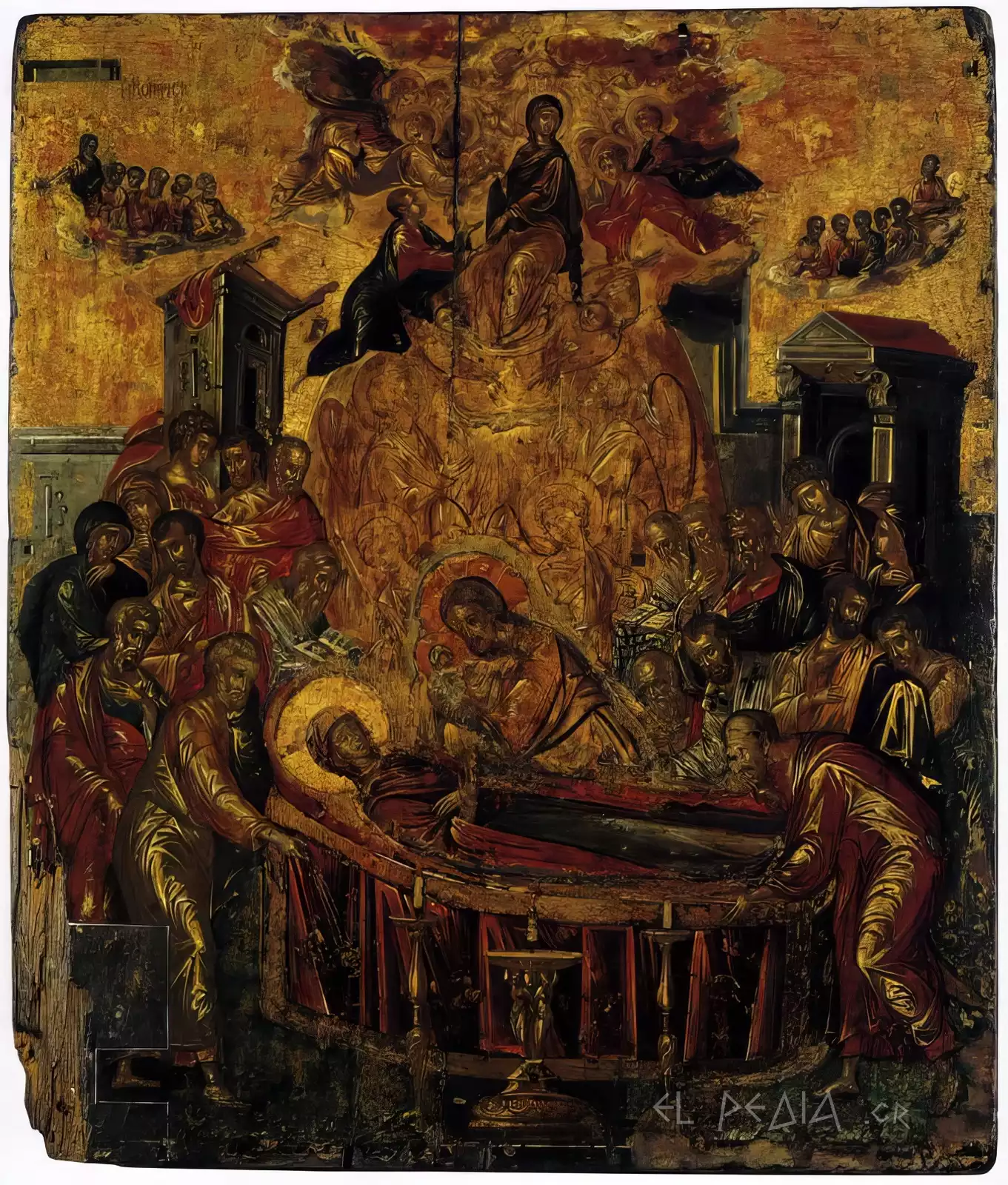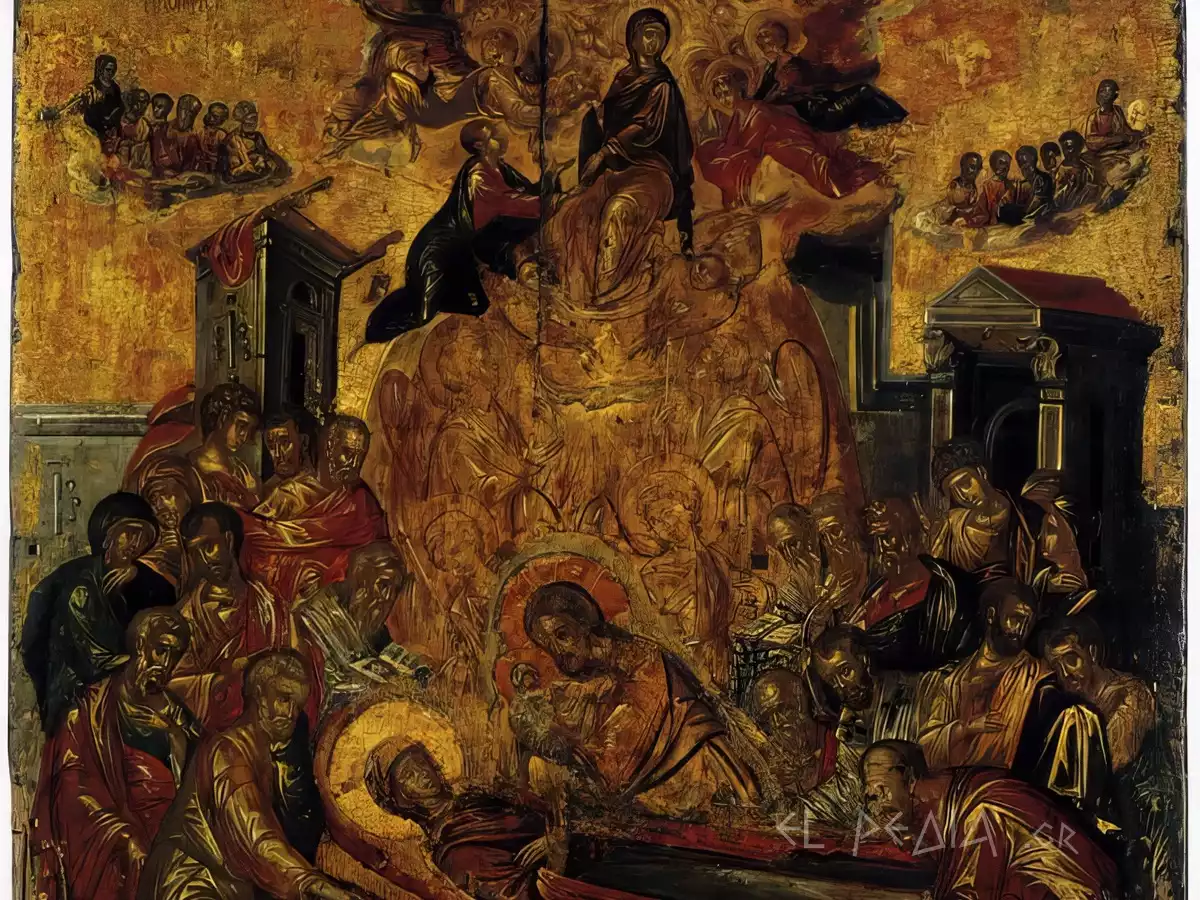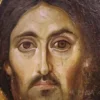
Title: The Dormition of the Theotokos
Artist: Doménikos Theotokópoulos
Type: Portable icon
Date: before 1567
Dimensions: 61.4 x 45 cm
Materials: Egg tempera and gold on wood
Location: Metropolitan Church of the Dormition of the Theotokos, Ermoupolis, Syros
The Dormition of the Theotokos by Theotokopoulos (El Greco) is one of the most important early works of the artist during his Cretan period. The work was created before his departure for Venice in 1567 and reflects his excellent training in the Cretan painting tradition. The composition follows the established iconographic rules of post-Byzantine art, while at the same time the artist’s first innovative tendencies in the depiction of forms and space are evident. The image presents the Dormition of the Theotokos surrounded by the Apostles, with Christ receiving her soul, while angels and hierarchs participate in the divine event. The detailed rendering of the faces, the elaborate use of gold, and the exceptional technique in the depiction of garments testify to Theotokopoulos’s high artistic education in the environment of Candia. The work is an important testament to his early artistic journey and his subsequent development in mannerism.
The Cretan Period and Style
The early artistic path of Doménikos Theotokópoulos in Crete is a fundamental stage for understanding his subsequent artistic development. His training in the workshop of Candia shaped his technical skills and artistic perception, while also providing him with a deep knowledge of the post-Byzantine iconographic tradition. The artistic atmosphere of 16th-century Crete, with the strong presence of Venetian influence and the simultaneous preservation of Byzantine tradition, created the appropriate environment for the development of his unique style.
In the Dormition of the Theotokos, Theotokopoulos demonstrates exceptional skill in applying the techniques of the Cretan school, combining traditional iconography with early innovations in the depiction of forms and space (Lafuente). The composition is characterized by the extremely detailed rendering of faces and garments, with particular emphasis on the depiction of folds and chiaroscuro. The use of gold background and the hierarchical arrangement of forms follow the traditional typology, but the internal dynamics of the composition foreshadow the artist’s later artistic explorations.
The technical perfection of the work reveals an in-depth knowledge of the materials and methods of egg tempera, while the exceptional quality of the goldsmithing in the background and the details of the garments testifies to the artist’s high specialization in the Cretan technical tradition. The careful study of color gradations and the detailed rendering of light areas create an exceptionally refined painting surface, highlighting the mastery of the still young artist.
This period of his artistic journey is characterized by the search for a personal expressive language within the limits of tradition. His skill in applying established techniques is combined with a discreet tendency towards innovation, which is mainly manifested in the plasticity of forms and the organization of the iconographic space. This composition is a characteristic example of the artist’s transitional period, where traditional style meets the first indications of his future artistic development.
Iconographic Analysis and Symbolism
The iconographic structure of the Dormition of the Theotokos follows the established typology of the post-Byzantine tradition, with Theotokopoulos enriching the theme through refined symbolic references. The central episode takes place in a space that combines earthly and heavenly elements, where the Theotokos rests on a funeral bed surrounded by the Apostles. The scene exudes a sense of sanctity and mystery.
At the center of the composition, the early art of Theotokopoulos highlights the figure of the Theotokos with exceptional delicacy and sensitivity (Sinclair). The arrangement of the figures follows a strict hierarchical organization, where each person occupies a specific position according to their significance in the iconographic program. The Apostles, placed in a semicircle around the funeral bed, express different emotional reactions, creating a complex psychological atmosphere that distinguishes the work from conventional depictions of the time.
The presence of Christ at the center of the composition, holding the soul of the Theotokos in the form of a swaddled infant, is a pivotal element of the iconography. This symbolic depiction, which is part of the long tradition of Byzantine art, is rendered with particular skill by the artist, who manages to combine traditional typology with a personal interpretative approach. The composition is further enriched by the presence of angelic figures and hierarchs, who participate in the divine event, creating a multi-layered iconographic ensemble.
The details in the depiction of garments and faces reveal the artist’s exceptional technical skill, while the use of the gold background enhances the metaphysical dimension of the scene. The careful study of expressions and gestures of the figures reveals a deep understanding of human psychology, an element that will become a characteristic feature of Theotokopoulos’s later artistic career.

Technical Execution and Innovations
The Dormition of the Theotokos by Theotokopoulos is distinguished by its exceptional technical perfection, which testifies to the artist’s high training in the Cretan painting tradition. The choice of egg tempera as a medium reflects a deep knowledge of traditional techniques, while the use of the gold background highlights his skill in goldsmithing.
The study of the technical characteristics of the image reveals a series of recent discoveries in the evolution of the artist’s style (Procopiou). The skillful management of color gradations and the detailed rendering of light areas create an exceptionally refined painting surface, which foreshadows his later innovations in the use of light.
In dimensions of 61.4 x 45 centimeters, the work presents a remarkable balance between detail and overall composition, with the careful processing of each element contributing to the creation of a harmonious whole. The application of gold leaf in the halos and details of the garments reveals an excellent understanding of traditional techniques, while the depiction of folds and volumes betrays a progressive perception of the plasticity of forms.
Of particular interest is the technical management of space, where the artist succeeds in creating the illusion of depth despite the limitations of the post-Byzantine iconographic tradition. The use of overlapping planes and the gradation of the sizes of the figures suggest an advanced understanding of perspective, which will be further developed in his later works.
The technical processing of the faces reveals Theotokopoulos’s ability to combine traditional typology with a personal interpretative approach. The subtle gradation of tones in the faces and the careful rendering of physiognomic features create a strong sense of individuality, while maintaining the hieratic character of the figures.
The Significance of the Work in the Artist’s Development
The Dormition of the Theotokos is a pivotal point in Theotokopoulos’s artistic journey, as it marks the transition between his Cretan period and his impending move to the West. The work, which is currently kept at the Metropolitan Church of Ermoupolis, encapsulates the essence of his artistic education in Candia and foreshadows his future explorations.
Through this composition, the dialectical relationship of the artist with tradition and innovation is evident. The spiritual atmosphere of the time, characterized by intense artistic fermentations in the field of Cretan art, is reflected in his personal interpretative approach to the subject (Pallucchini). The exceptional technical perfection of the work testifies to the complete assimilation of the Cretan painting tradition, while at the same time highlighting the search for a personal expressive language.
The study of the stylistic characteristics of the image reveals the complex artistic personality of Theotokopoulos, who manages to uniquely combine traditional iconography with personal innovations in the depiction of forms and space. The exceptional quality of the goldsmithing in the background and the details of the garments, combined with the refined use of egg tempera, demonstrate his high technical training in the Cretan tradition.
The significance of the work also lies in the fact that it is one of the few surviving testimonies of the artist’s early period. Its study provides valuable information about his artistic formation and the influences he received during his training in Crete. The image is a characteristic example of the high quality of 16th-century Cretan painting and its significant contribution to the evolution of post-Byzantine art.
The Dormition of the Theotokos by Theotokopoulos: A Milestone of His Early Art
The Dormition of the Theotokos is a milestone work for understanding the artistic journey of Doménikos Theotokópoulos. The exceptional technical perfection, the detailed rendering of forms, and the balanced composition demonstrate the complete assimilation of the Cretan painting tradition by the artist. At the same time, the innovative tendencies evident in the depiction of space and volumes foreshadow his future explorations.
The work, which is currently kept at the Metropolitan Church of Ermoupolis, is a valuable testament to Theotokopoulos’s early period and the high quality of 16th-century Cretan painting. Its study provides important information about the painter’s artistic formation and the influences he received during his training in Crete, while also shedding light on the contribution of the Cretan school to the evolution of post-Byzantine art.
elpedia.gr
Bibliography
- Lafuente, E. “El Greco: Some Recent Discoveries.” The Burlington Magazine for Connoisseurs (1945).
- Pallucchini, R. “Some Early Works by El Greco.” The Burlington Magazine (1948).
- Procopiou, AG. “El Greco and Cretan Painting.” The Burlington Magazine (1952).
- Sinclair, S. “Viewing El Greco.” Art History (2004).

